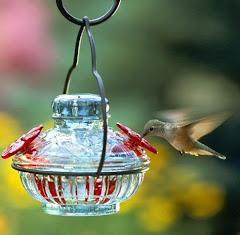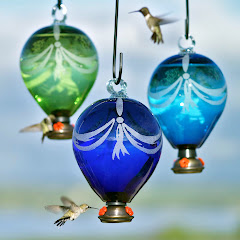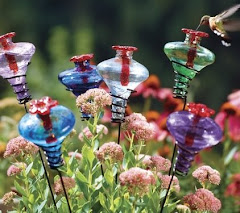
Thursday, October 23, 2008
Time to come in from the cold
It's that time of year when first-freezes will do a number on your hummingbird feeders - so when weather is unpredictable and temperatures drop suddenly, it's time to put your feeders in winter storage.

Glass and ceramic hummingbird feeders (and seed feeders for songbirds) need to be stored indoors or in your garage during freezing weather. Since hummingbird feeders are filled with liquid nectar, freezing temperatures will cause the nectar to expand and possibly crack or damage your feeders. Sometimes there are hairline cracks that can snap a glass piece in two when frozen nectar expands.
Any exposed terra cotta in your hummingbird and songbird feeders can absorb moisture which can also freeze and break your ceramic pieces. I learned the hard way last year when I kept a ceramic bird bath out in my yard all winter and had shards of ceramic on my porch after a big freeze. Whoops!

Even hummingbird feeders that are plastic are best stored for winter. The freezing nectar can warp plastic, and hard freezes can break plastic pieces. UV light weakens plastic, and remnant nectar can grow some nasty bacteria that adheres and corrodes plastic. You can actually ruin and destroy your plastic feeders by leaving old nectar in storage. If there's snow on the ground and ice on the drive you won't be seeing hummingbirds anyway. Best to just put your feeders away for next season!
It always helps your hummingbird plants if you winterize your garden - lay down some fresh mulch to add nutrients to the soil, and add compost materials to your beds. Throughout winter remember to water plants if you don't snow or rain for a couple weeks - plastic rain gauges near your plants are a great way to monitor the actual water your plants receive. In desperately dry climates you can add polymers to the soil that swell when water is plentiful and then slowly distribute the moisture into the soil. Lots of nurseries and gardening catalogs sell these and they are great to use in xeric gardens year-round!
Sunday, October 19, 2008
Flying in the fast lane
There's no question - one of the coolest facts about hummingbirds is that they can fly forward, backward, sideways and upside down! A hummingbird can hover over a feeder or flower while drinking nectar seemingly suspended in space. Zipping in and out, hummingbirds are the ace-fliers of the bird world. No other bird can fly like a hummer can... but how?
There are two physiological characteristics of the hummingbird that allow it to do their spectacular aerial maneuvers: 1. the hummingbird's pectoral muscles account for 30% of their body weight and 2. the hummingbird can move it's wings in a circular motion.
Pectoral muscles in birds are best known as the breast - and in most breeds the pectoral percentage is about 15-25% of the bird's total weight. Human pectoral muscles are much less developed than birds' - our main muscle groups are in our quadriceps (our legs and buttocks - which is why we walk and don't fly). Even the bulked up physiques of body builders don't hold a candle to the "pec power" of birds. Arnold Schwartzenegger at his chest-popping Mr. Universe best had pectoral muscles at least 7 times weaker than a hummingbird! So much for the Governator...
Since hummingbirds can move their wings in a circle, they are able to get lift and thrust in both directions of their wings. Average birds flap their wings to get lift (upward motion) and thrust (forward motion). Hummingbirds rotate their wings to get lift both upward and downward and thrust both forward and backward. To hover, hummingbirds move their wings in a figure eight movement - the same way you'd move your arms while treading water.
As if their normal flying feats weren't enough, hummingbirds can also fly upside down! To evade other flying predators like hawks and owls the hummingbird can fly short distances completely inverted. Fast thinking and fast acting are the key to the hummingbird's success in out-maneuvering much larger and fiercer birds.
Hummingbirds are definitely built for speed, and the smaller the species the faster their wing beats actually are. Magnificent hummingbirds (E. Fulgen or Rivoli's hummingbird) fly the slowest of all hummingbirds, with 10-15 wing beats per second. Ruby-throat and Rufous hummingbirds average around 53 wing beats per second. The Bumblebee hummingbird (Atthis Heliosa) is the world's smallest bird and their wing beats are more than 80 per second! Hummingbirds fly around 27 miles per hour, but have been clocked at doing up to 45-50 MPH. That's twice as fast as the fastest human can run.
There are two physiological characteristics of the hummingbird that allow it to do their spectacular aerial maneuvers: 1. the hummingbird's pectoral muscles account for 30% of their body weight and 2. the hummingbird can move it's wings in a circular motion.
Pectoral muscles in birds are best known as the breast - and in most breeds the pectoral percentage is about 15-25% of the bird's total weight. Human pectoral muscles are much less developed than birds' - our main muscle groups are in our quadriceps (our legs and buttocks - which is why we walk and don't fly). Even the bulked up physiques of body builders don't hold a candle to the "pec power" of birds. Arnold Schwartzenegger at his chest-popping Mr. Universe best had pectoral muscles at least 7 times weaker than a hummingbird! So much for the Governator...
Since hummingbirds can move their wings in a circle, they are able to get lift and thrust in both directions of their wings. Average birds flap their wings to get lift (upward motion) and thrust (forward motion). Hummingbirds rotate their wings to get lift both upward and downward and thrust both forward and backward. To hover, hummingbirds move their wings in a figure eight movement - the same way you'd move your arms while treading water.
As if their normal flying feats weren't enough, hummingbirds can also fly upside down! To evade other flying predators like hawks and owls the hummingbird can fly short distances completely inverted. Fast thinking and fast acting are the key to the hummingbird's success in out-maneuvering much larger and fiercer birds.
Hummingbirds are definitely built for speed, and the smaller the species the faster their wing beats actually are. Magnificent hummingbirds (E. Fulgen or Rivoli's hummingbird) fly the slowest of all hummingbirds, with 10-15 wing beats per second. Ruby-throat and Rufous hummingbirds average around 53 wing beats per second. The Bumblebee hummingbird (Atthis Heliosa) is the world's smallest bird and their wing beats are more than 80 per second! Hummingbirds fly around 27 miles per hour, but have been clocked at doing up to 45-50 MPH. That's twice as fast as the fastest human can run.
Friday, October 10, 2008
"Fall" in love with mulching
I'm looking out my living room window and see treetops touched with gold, flaming orange, russet and burgundy. Autumn is my favorite time of year - the chill in the air, getting my sweaters out from storage, a hot chai tea at the last farmer's market of the year. I get invigorated taking my beagle, Chester, out for his walk... seeing nature turn itself toward the next season. Fall happens so beautifully, colors lingering and then fading.
I'm more aware of my connection with the plants around me in Fall - Spring always comes as a surprise ("Hey look! the trees have budded this weekend!") and Summer I'm busy "doing" instead of "looking". I get a chance to slow down and appreciate what's around. But before I snuggle up with my down blanket and a j.d. salinger novel, I know I need to prepare my garden for the cold weather that's coming.
Preparing your garden for winter will help your hummingbird plants survive harsh weather, and keeps the work you'll do in spring down to a minimum. One of the best and least expensive things to do now is to mulch, mulch, mulch!
Mulching brings organic material into your soil and the extra nutrients will feed your hummingbird plants throughout the cold and frozen months.You don't have to look far to find organic mulch - it's what's falling from your trees right now! Harvest the falling leaves from the trees in your yard for inexpensive and quick composting material to add to your flowerbeds. Handheld mulchers will make short work of a pile of leaves, and you won't be bagging up trash bag after trash bag of recyclable material to go to a landfill.
Other great materials for mulch are tree and bush clippings. Many arborists will gladly donate their yard waste (they have it by the truckload this time of year!) and mulching small branches will give you a more substantial mulch than leaves alone. Beware of pine needles and your hummingbird plants though - pine needles are very acidic and you have to make sure your plants can tolerate a rise in acidity. Mulching helps your garden retain moisture, delivering water to the soil by preventing evaporation. Mulch should be porous, allowing air and water through. If you have hummingbird plants that need extra heat (plants that thrive in full-sun) use decorative rock for mulch. Rocks reflect light and hold heat much more than wood or "soft" mulches.
If you're looking to create new flowerbeds for spring, now is the time to let Mother Nature to do the yard work. Last year I wanted a new patch in my yard to grow pumpkins (I have a great batch of jack-o-lanterns now!). I laid out the area I needed and used layers of newspaper and cardboard weighted down with bricks over the turf I needed to remove. By spring the turf was dead from "suffocation" and lack of light, and the area was easier than pie to rota-till. Since the grass was changed to a soft mulch, I also did not have to amendthe soil much with extra compost and fertilizer!
I'm more aware of my connection with the plants around me in Fall - Spring always comes as a surprise ("Hey look! the trees have budded this weekend!") and Summer I'm busy "doing" instead of "looking". I get a chance to slow down and appreciate what's around. But before I snuggle up with my down blanket and a j.d. salinger novel, I know I need to prepare my garden for the cold weather that's coming.
Preparing your garden for winter will help your hummingbird plants survive harsh weather, and keeps the work you'll do in spring down to a minimum. One of the best and least expensive things to do now is to mulch, mulch, mulch!
Mulching brings organic material into your soil and the extra nutrients will feed your hummingbird plants throughout the cold and frozen months.You don't have to look far to find organic mulch - it's what's falling from your trees right now! Harvest the falling leaves from the trees in your yard for inexpensive and quick composting material to add to your flowerbeds. Handheld mulchers will make short work of a pile of leaves, and you won't be bagging up trash bag after trash bag of recyclable material to go to a landfill.
Other great materials for mulch are tree and bush clippings. Many arborists will gladly donate their yard waste (they have it by the truckload this time of year!) and mulching small branches will give you a more substantial mulch than leaves alone. Beware of pine needles and your hummingbird plants though - pine needles are very acidic and you have to make sure your plants can tolerate a rise in acidity. Mulching helps your garden retain moisture, delivering water to the soil by preventing evaporation. Mulch should be porous, allowing air and water through. If you have hummingbird plants that need extra heat (plants that thrive in full-sun) use decorative rock for mulch. Rocks reflect light and hold heat much more than wood or "soft" mulches.
If you're looking to create new flowerbeds for spring, now is the time to let Mother Nature to do the yard work. Last year I wanted a new patch in my yard to grow pumpkins (I have a great batch of jack-o-lanterns now!). I laid out the area I needed and used layers of newspaper and cardboard weighted down with bricks over the turf I needed to remove. By spring the turf was dead from "suffocation" and lack of light, and the area was easier than pie to rota-till. Since the grass was changed to a soft mulch, I also did not have to amendthe soil much with extra compost and fertilizer!
Subscribe to:
Posts (Atom)

Hummingbird in Napa, CA


